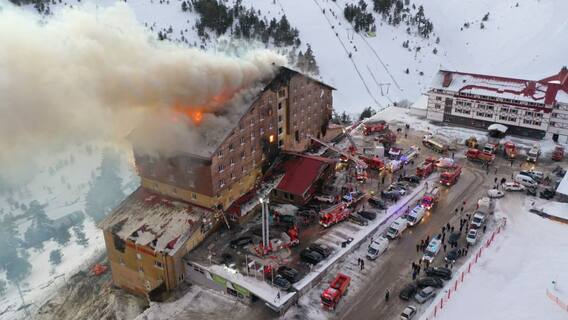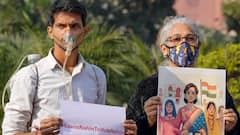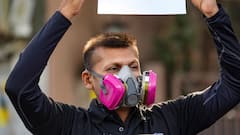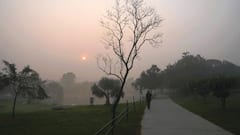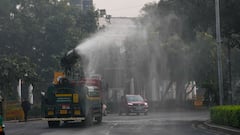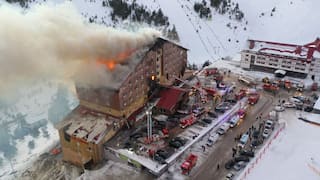Delhi's Brown Air Leaves Residents Teary-Eyed Ahead Of Diwali As AQI Rises — Visuals From A Choking City
The air quality in Delhi and NCR remained in 'severe' category as the AQI breached the 450-mark on Friday leaving the residents with respiratory and eye related issues.

Delhi woke up to another smoggy morning as the overall air quality remained in the “severe category”. According to data by the Central Pollution Control Board at 7 am on Saturday, the national capital logged an Air Quality Index of 413.
The condition in the adjacent Noida also remained the same as the national capital. In Noida’s Sector 116, the AQI was recorded at 426 while in Sector 62, it was 428, according to the CPCB.
Meanwhile, the worsening pollution has started to take a toll on the health of the residents as doctors expressed concerns that air pollution is causing an increase in respiratory and eye problems among children and the elderly.
#WATCH | Delhi | Latest visuals from Vasant Kunj area show haze in the air as air quality in the city continues to be in 'Severe' category.
— ANI (@ANI) November 4, 2023
Visuals shot at 8:30 am. pic.twitter.com/GLEtxY4YAz
While the pollution levels showed a marginal decrease in the national capital and adjoining areas overnight due to a relatively better wind speed, the concentration of PM 2.5 was still more than 80 times the healthy limit prescribed by the World Health Organisation.
The government-prescribed safe limit for the concentration of PM 2.5 — fine particulate matter capable of penetrating deep into the respiratory system and triggering health problems — is 60 micrograms per cubic metre which was breached by seven to eight times at multiple locations throughout Delhi-NCR.
#WATCH | Delhi | ANI drone camera footage from the Signature Bridge shows a thick layer of haze in the air. Visuals shot at 7:45 am today.
— ANI (@ANI) November 4, 2023
The air quality in Delhi continues to be in 'Severe' category as per CPCB (Central Pollution Control Board). pic.twitter.com/2VlcdHUVA1
Early morning visuals shared on social media show a thick layer of smog over the national capital and adjoining regions, compelling many to forgo their morning walks, sports, and other outdoor activities.
Drone visuals of Yamuna River near Delhi's Wazirabad area as AQI of the national capital plummets to 'severe' category.#DelhiAirQuality #DelhiAirPollution pic.twitter.com/u6n9W9LX5E
— Press Trust of India (@PTI_News) November 4, 2023
#WATCH | Delhi | More visuals from ANI drone camera from the ITO area shows a layer of haze in the air. Visuals shot at 7:30 am today.
— ANI (@ANI) November 4, 2023
The air quality in Delhi continues to be in 'Severe' category as per CPCB (Central Pollution Control Board) pic.twitter.com/noSrqcnZCR
VIDEO | AQI continues to remain in 'severe' category in Delhi. Visuals from ITO.#DelhiAirQuality #DelhiPollution pic.twitter.com/R1kxswQM06
— Press Trust of India (@PTI_News) November 4, 2023
Unfavourable meteorological conditions, emissions from vehicles, paddy straw burning, firecrackers, and other local pollution sources contribute to the hazardous air quality levels in Delhi-NCR during the winter every year, typically between November 1 and November 15.
#WATCH | Visuals from Noida as Air quality continues to deteriorate
— ANI (@ANI) November 4, 2023
In Noida Sector-116 AQI stands at 426 and in Noida Sector 62 at 428 as per the Central Pollution Control Board (CPCB). pic.twitter.com/yo2KDzjrue
A gradual drop in temperatures coupled with calm winds that trap pollution, and a surge in post-harvest paddy straw burning across Punjab and Haryana resulted in declining air quality in Delhi-NCR over the past week.
As per CPCB data, AQI in Delhi increased by more tham 200 points between October 27 and November 3 culminating in a descent into the "severe plus" category (above 450) on Friday.
Trending News
Top Headlines










